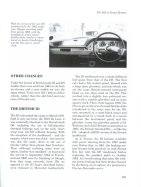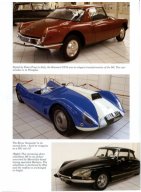|
||||||||||||||||||||||
|
Citroën DS The Complete Story by Jon
Pressnell Does the world really need another book on the DS? The two definitive works are the John Reynolds/Jan De Lange book and Olivier de Serres' tome - the latter being in French. Supplementary books are the two DS de mon Père volumes which are also in French. Although comparisons are odious, it is inevitable that this book will be compared with "The Original Citroën DS" by John Reynolds and Jan de Lange, if only because they are both in English - indeed Jon Pressnell acknowledges a particular debt to this latter book. Jon Pressnell is a regular contributor to "Classic & Sports Car: magazine and has previously published books on the Morris Minor and Mini. Unlike John Reynolds who is a Citroën enthusiast, Jon Pressnell drives a MG Midget and a Renault 4. First impressions are quite good - the dust jacket shows a Slough-built ID but skimming through it reveals that it is mainly monochrome with the 31 colour prints occupying a block in the middle of the book. Most of the monochrome pictures and a number of the colour ones will be familiar to enthusiasts. The layout employs two columns per page and is, in my opinion, rather dull and staid. The type face used - New Century Schoolbook looks old fashioned too. Rather like John Reynolds' latest book "From A To X", this book employs blocks printed on a grey background for specific topics and this does break the monotony a bit. So, first impressions are not wonderful but the important thing is the contents. As is de rigeur, the book starts with a potted history of Citroën before the DS, together with an all too brief biography of André Citroën. Nothing new here. It then moves on to discuss those who were responsible for the creation of the car - André Lefèbvre, Pierre Boulanger, Walter Becchia, Paul Magès and of course, Flaminio Bertoni. Once again, there is nothing new here - unlike Fabien Sabatès' book on Bertoni which contained a number of revelations including some hitherto unpublished pictures of the prototypes that led eventually to the DS. Nevertheless, this era is covered in some depth although the Auto Journal affair is glossed over. Pressnell then turns to the well documented teething problems and then enters into a rather dry blow-by-blow account of all the modifications made during the car's 20 year history. Like John Reynolds, he splits this section up into DS, ID and Breaks. It is not until more than halfway through the book that things become interesting - chapter 11 deals with the Cabriolets and Chapron vehicles including the DS Présidentielle. This is followed by a chapter on the other carrossiers and I must admit I found this fascinating, albeit all too brief. Included are the elegant Bossaert Gété GT19 and the André Ricou coupés. The Pichon Parat and Barbero coupés are also mentioned but only the latter is pictured. I could have provided Presnell with pictures of the Barbero cars. The Tissier vehicles are also mentioned but only one well known picture of the SA Hollander vehicle is included.
|
|
||||
|
Things get even better in chapter 13 which addresses itself to some of the wilder ideas mooted for the development of the DS - anti-roll suspension, hydraulically operated air brake, new engines including a two stroke, supercharged V4 and of course, Véhicule S - the long awaited but never delivered D Sport. There then follows a brief diversion into the realms of the SM and then we return to restyling the DS though surprisingly no mention is made of Robert Opron's proposals for a restyle of the rear. The chapter ends with the Panhard DS. The next chapter deals with the DS in competition and I experienced a distinct sense of déjà-vu when I read the opening paragraph which is all but identical to the words I used in an article published several years ago in the Citroënian and which can also be read on my website. Still, imitation is the sincerest form of flattery. Chapter 15 covers the DS in Great Britain and again I am forced to compare this with "From A To X" and "The Original DS", both of which go into more detail. Chapter 16 deals with the DS in other non-French markets and again is somewhat superficial - especially with regard to North America. I was however amused by a picture of a Californian DS 21 with the licence plate VAZY PP. Chapter 17 is entitled The Legacy Of The DS and it is here that Pressnell demonstrates his objectivity. This chapter is somewhat controversial but you will have read not dissimilar observations in Iconoclast. The last chapter deals with buying a DS and contains a lot of sensible advice including an exhortation to join the CCC (although it quotes the old website URL). Finally there are two appendices - one of production figures and the other explaining how the hydraulic systems work. Needless to say, this is rather hard going and I would recommend that you look at this pageto see the system portrayed using didactic GIFs. A couple of gripes - Barbero is inconsistently spelled Barbero and Barbaro and a picture of a 1962 ID has been reversed to show what looks like a right hand drive vehicle. Some other pictures have been crudely cropped (though not as badly as in Sabatès' book). It must be said that Pressnell's style is probably better suited to magazine articles - he is concise to the point of terseness and it is only when he describes the DS driving experience that any real enthusiasm shines through. Over all then, a thumbs up for this book. Had The Original DS not been published a few years ago, my enthusiasm would be greater. Most of the book covers old ground and when it does chart new territory it is a little too lightweight. French speakers should buy Olivier de Serres' book. So, does the world need another DS book? Probably not - but then again, I enjoyed reading it. ISBN 1 86126 055 5 |
|||||
| © 1999 Julian Marsh | |||||




